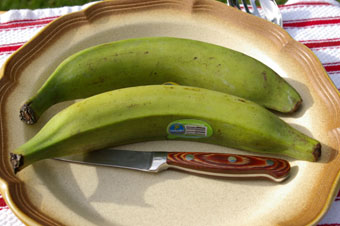
What is a Plantain: Plantains Versus Bananas
| published June 26, 2014 |
By Michael Sigler
Thursday Review contributor
Plantains are a member of the banana family. They are a starchy, low-sugar variety that is cooked before serving as it is unsuitable raw. It is used in many savory dishes somewhat like a potato would be used and is very popular in Western Africa and the Caribbean countries. It is usually fried or baked, but can also be sautéed or mashed in dishes.
Plantains are native to India and are grown most widely in tropical climates. Plantains are sometimes referred to as the pasta and potatoes of the Caribbean. Sold in the fresh produce section of the supermarket, they usually resemble green bananas but ripe plantains may be black in color. This vegetable-banana can be eaten and tastes different at every stage of development. The interior color of the fruit will remain creamy, yellowish or lightly pink. When the peel is green to yellow, the flavor of the flesh is bland and its texture is starchy. As the peel changes to brown or black, it has a sweeter flavor and more of a banana aroma, but still keeps a firm shape when cooked.
The plantain averages about 65% moisture content and the banana averages about 83% moisture content. Since hydrolysis, the process by which starches are converted to sugars, acts fastest in fruit of higher moisture content it converts starches to sugars faster in bananas than it does in plantains. A banana is ready to eat when the skin is yellow whereas a plantain is not ready to eat "out of hand" until hydrolysis has progressed to the point where the skin is almost black.
| Plantains | Bananas |
|---|---|
| Starchy | Sweet |
| Used as a vegetable | Eaten as a fruit |
| Longer than bananas | Shorter than plantains |
| Thicker skin | Thinner skin |
| Resemble green bananas, but may be green, yellow |
Color is green when not fully ripe, yellow when ripe |
Many people confuse plantains with bananas, and some of the differences are noted above. Although they look a lot like green bananas and are a close relative, plantains are very different. They can be used as a vegetable in many recipes, especially in Latin America and Africa. Plantains are longer than bananas and they have thicker skins. They also have natural brown spots and rough areas. In fact some plantains are mostly black in color.
The wonderful thing about plantains is that they truly are a versatile food. As a plantain ripens, its high starch content changes to sugar. Plantains are good at any stage; it just depends on what you want to make. Plantains are a relative of the banana, but are bigger, less sweet and need to be cooked before they are eaten. Plantains also keep their shape when cooked, unlike bananas, which get mushy.
Green or "unripe" plantains are starchy vegetables. They can be used in soups, stews, boiled and mashed. Most Puerto Rican recipes that use plantains call for green plantains and need to be VERY green without a hint of yellow.
The next stage of ripeness is when the skin is mostly yellow with a few black speckles. In this stage of ripeness, the plantain has lost some of its starch and is slightly sweet. Plantains amarillos are usually fried but can be boiled and baked as well. To fry them just peel, slice, and fry. In Puerto Rico both green and amarillos are served with meals as a side dish.
Related Thursday Review articles:
The Brussels Sprouts Controversy; Michael Sigler; Thursday Review; June 14, 2013.
